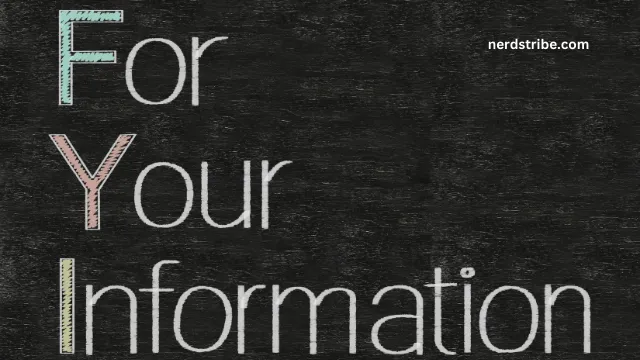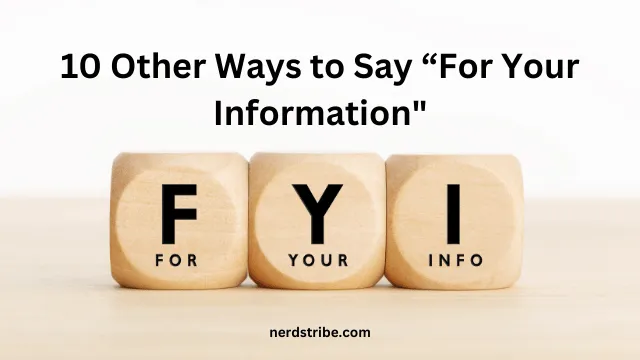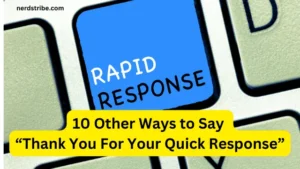We all know the phrase “For Your Information” (FYI) — it’s quick, simple, and to the point. However, sometimes it can feel a bit too transactional or even abrupt, especially when trying to convey a message with warmth or thoughtfulness.
Whether you’re sending an email at work or chatting with a friend, how you communicate can significantly impact how the message is received. This article explores 10 alternative ways to express “For Your Information,” offering more engaging and nuanced ways to share important details.
While “FYI” is widely used for its brevity, there are times when a more considerate or formal approach is needed. Choosing the right phrase can set the tone for the message and show that you care about how it is perceived. In this post, we’ll dive into alternatives that cater to different contexts — from professional to casual and everything in between.
By learning these alternatives, you can ensure your communication remains clear, respectful, and fitting for any situation. So, if you’re looking to broaden your vocabulary and refine your messaging style, let’s explore 10 alternative ways to say “For Your Information” and why each can be a more fitting choice.

Contents
- 0.1 1. “Please be advised that…”
- 0.2 2. “Kindly note that…”
- 0.3 3. “To inform you…”
- 0.4 4. “Please be informed that…”
- 0.5 5. “This is to inform you that…”
- 0.6 6. “For your reference…”
- 0.7 7. “Just to let you know…”
- 0.8 8. “You may be interested to know that…”
- 0.9 9. “I wanted to let you know that…”
- 0.10 10. “Heads up…”
- 1 Conclusion
- 2 FAQs
1. “Please be advised that…”
- Conveys: A formal and polite way of notifying someone of important information.
- Usage: Ideal in professional settings, especially when communicating something official or requiring action.
- Example: “Please be advised that the office will be closed for maintenance this weekend.”
2. “Kindly note that…”
- Conveys: A polite request for attention to important details.
- Usage: Frequently used in business correspondence and offers a respectful way to highlight key information.
- Example: “Kindly note that the document must be submitted by Friday.”
3. “To inform you…”
- Conveys: A clear and direct introduction to the information being shared.
- Usage: Best used when delivering straightforward updates or notices.
- Example: “To inform you, the project deadline has been moved to next week.”
4. “Please be informed that…”
- Conveys: A formal and slightly more emphatic version of “To inform you.”
- Usage: Often employed in official communications and professional environments.
- Example: “Please be informed that your application has been successfully processed.”
5. “This is to inform you that…”
- Conveys: A very formal, concise introduction to a notification.
- Usage: Commonly used in corporate, legal, or governmental communication.
- Example: “This is to inform you that the meeting will be rescheduled for Thursday.”

6. “For your reference…”
- Conveys: Sharing information for the recipient’s future use or consideration.
- Usage: Perfect for emails or communications where the information serves as a reference point.
- Example: “For your reference, I have attached the full project details.”
7. “Just to let you know…”
- Conveys: A casual and friendly way to share updates.
- Usage: Best suited for informal communications with friends, family, or colleagues.
- Example: “Just to let you know, I’ll be working remotely tomorrow.”
8. “You may be interested to know that…”
- Conveys: Suggests that the information may be valuable or intriguing to the recipient.
- Usage: Works well for situations where the information is important, but not urgent.
- Example: “You may be interested to know that the event has been rescheduled for next month.”
9. “I wanted to let you know that…”
- Conveys: A personal and friendly way to share information.
- Usage: Useful in informal settings or when you wish to express something with a bit more warmth.
- Example: “I wanted to let you know that I enjoyed our lunch today.”
10. “Heads up…”
- Conveys: A quick, casual alert or reminder.
- Usage: Ideal for informal and quick notifications that require attention or action.
- Example: “Heads up! The meeting time has been changed to 3 PM.”
Conclusion
Exploring alternatives to the phrase “For Your Information” enhances both the clarity and tone of communication. By choosing words that align with the specific context and audience, you can convey the same message while making it more engaging, respectful, or friendly.
Whether you’re sending an email to your boss or giving a heads-up to a friend, the right phrase can go a long way in strengthening your communication skills. By using the alternatives we’ve explored, you’ll be able to navigate different conversations with ease and precision.
Remember, the choice of phrase you use can reflect not only the content of your message but also the relationship you have with the recipient. So, next time you need to convey information, consider which alternative will make your communication feel more thoughtful, appropriate, and well-received.
FAQs
When should I use “FYI” instead of these alternatives?
“FYI” works well for brief, casual notifications but may lack the nuance needed for more formal or considerate communication.
Are these alternatives only for professional use?
No, some of these phrases, like “Just to let you know” and “Heads up,” are perfect for informal settings as well.
Can I use these alternatives in emails?
Absolutely! These alternatives can be used in emails, especially when you want to adjust the tone depending on the recipient.
Which phrase is most formal?
“Please be advised that” and “This is to inform you that” are among the most formal phrases for professional use.
What if I want to sound more friendly?
For a friendly tone, try using “I wanted to let you know that” or “Just to let you know.”
Can these alternatives be used in text messages?
Yes, phrases like “Just to let you know” and “Heads up” are perfectly suitable for text messages and casual conversations.








